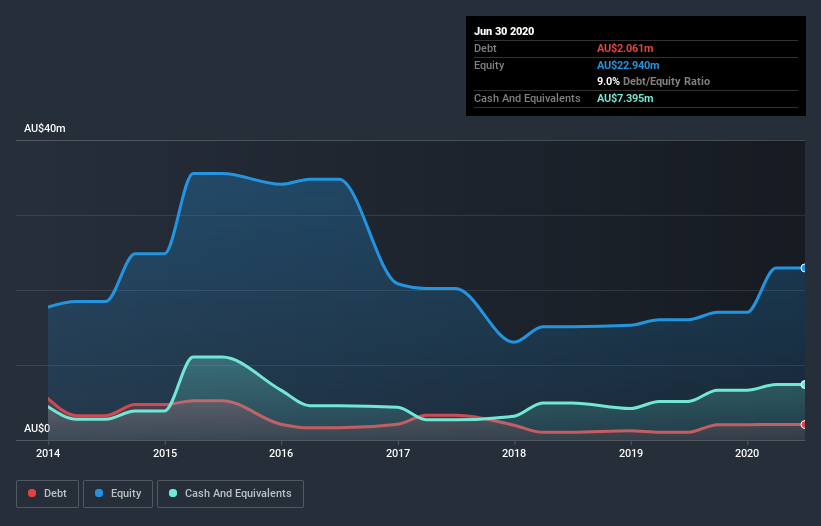These 4 Measures Indicate That Vmoto (ASX:VMT) Is Using Debt Safely
David Iben put it well when he said, 'Volatility is not a risk we care about. What we care about is avoiding the permanent loss of capital.' So it seems the smart money knows that debt - which is usually involved in bankruptcies - is a very important factor, when you assess how risky a company is. We can see that Vmoto Limited (ASX:VMT) does use debt in its business. But the real question is whether this debt is making the company risky.
When Is Debt A Problem?
Generally speaking, debt only becomes a real problem when a company can't easily pay it off, either by raising capital or with its own cash flow. If things get really bad, the lenders can take control of the business. While that is not too common, we often do see indebted companies permanently diluting shareholders because lenders force them to raise capital at a distressed price. Of course, plenty of companies use debt to fund growth, without any negative consequences. When we examine debt levels, we first consider both cash and debt levels, together.
View our latest analysis for Vmoto
What Is Vmoto's Net Debt?
You can click the graphic below for the historical numbers, but it shows that as of June 2020 Vmoto had AU$2.06m of debt, an increase on AU$1.04m, over one year. But on the other hand it also has AU$7.39m in cash, leading to a AU$5.33m net cash position.
How Strong Is Vmoto's Balance Sheet?
According to the last reported balance sheet, Vmoto had liabilities of AU$8.21m due within 12 months, and liabilities of AU$453.6k due beyond 12 months. Offsetting this, it had AU$7.39m in cash and AU$4.22m in receivables that were due within 12 months. So it actually has AU$2.96m more liquid assets than total liabilities.
This surplus suggests that Vmoto has a conservative balance sheet, and could probably eliminate its debt without much difficulty. Succinctly put, Vmoto boasts net cash, so it's fair to say it does not have a heavy debt load!
It was also good to see that despite losing money on the EBIT line last year, Vmoto turned things around in the last 12 months, delivering and EBIT of AU$1.3m. When analysing debt levels, the balance sheet is the obvious place to start. But you can't view debt in total isolation; since Vmoto will need earnings to service that debt. So if you're keen to discover more about its earnings, it might be worth checking out this graph of its long term earnings trend.
But our final consideration is also important, because a company cannot pay debt with paper profits; it needs cold hard cash. Vmoto may have net cash on the balance sheet, but it is still interesting to look at how well the business converts its earnings before interest and tax (EBIT) to free cash flow, because that will influence both its need for, and its capacity to manage debt. Over the last year, Vmoto actually produced more free cash flow than EBIT. There's nothing better than incoming cash when it comes to staying in your lenders' good graces.
Summing up
While we empathize with investors who find debt concerning, you should keep in mind that Vmoto has net cash of AU$5.33m, as well as more liquid assets than liabilities. And it impressed us with free cash flow of AU$3.1m, being 245% of its EBIT. So is Vmoto's debt a risk? It doesn't seem so to us. When analysing debt levels, the balance sheet is the obvious place to start. But ultimately, every company can contain risks that exist outside of the balance sheet. For example, we've discovered 3 warning signs for Vmoto that you should be aware of before investing here.
If you're interested in investing in businesses that can grow profits without the burden of debt, then check out this free list of growing businesses that have net cash on the balance sheet.
This article by Simply Wall St is general in nature. It does not constitute a recommendation to buy or sell any stock, and does not take account of your objectives, or your financial situation. We aim to bring you long-term focused analysis driven by fundamental data. Note that our analysis may not factor in the latest price-sensitive company announcements or qualitative material. Simply Wall St has no position in any stocks mentioned.
Have feedback on this article? Concerned about the content? Get in touch with us directly. Alternatively, email editorial-team@simplywallst.com.

 Yahoo Finance
Yahoo Finance 
